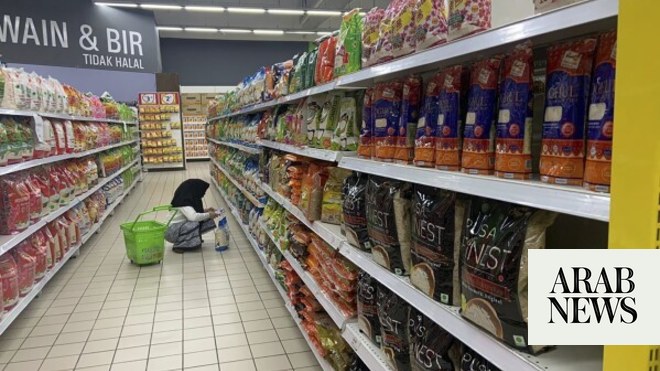
KUALA LUMPUR: Malaysian shoppers are emptying rice shelves as panic-buying spreads across a country that is grappling with rising prices following India’s decision to ban exports of the food staple.
International rice supply has been squeezed after the world’s biggest rice exporter banned shipments of the grain in July. This has led to rising costs and concerns over supply shortages in Asia, which accounts for about 90 percent of global rice consumption.
The ban’s impacts are being felt particularly keenly in Malaysia, a country of more than 32 million people that imports about a third of its rice needs.
With the retail price of imported white rice estimated to have risen by more than 30 percent last month, retailers in Kuala Lumpur have cited a shortage of local rice supply. This followed people seeking out cheaper options and panic-buying in different parts of the country.
“We don’t have the stock for local rice, and it has been like that for quite some time,” Sin, a clerk at Usaha Jaya wholesaler in Kuala Lumpur, told Arab News on Wednesday.
Most consumers now have to opt for the more expensive imported rice due to a shortage of local grain, said Sin, whose shop mainly supplies smaller stores in the capital.
“Nowadays, most people are buying imported rice because there is no supply of local rice. The cost of rice has increased a lot,” he said.
Malaysia this week introduced a subsidy and other measures to lower rice prices amid the crisis, including a task force to inspect local supply chains. Prime Minister Anwar Ibrahim has even warned of legal action against anyone found hoarding rice.
The government maintains that enough rice is available, with Agriculture and Food Security Minister Mohamad Sabu reportedly saying on Monday that there was no shortage of rice in the country and urging people not to panic-buy.
But Khor Cheng Hai, who sells rice at Kindness Enterprise, said he has been unable to secure stock of locally produced rice.
“Before this, there was panic-buying among our customers. But now, not anymore … We sell imported rice here, we tried to order local rice, but (wholesalers) said there is no stock,” Khor told Arab News.
“It’s not just my shop, my customers went to (other shops) and they complained that there is no local rice too. The government always said in the media that there were enough stocks of local rice.
“But when we ordered (these), there was no local rice available. What can we do?”
Malaysia’s rice crisis highlights faults within an industry that has been “trending downward,” said Prof. Fatimah Mohamed Arshad, a senior fellow at the Institute for Democracy and Economic Affairs.
“As production declines, the dependency on imports increases together with imported inflation,” Arshad said in a statement.
“India’s export-ban shock plunged the country into ‘rice shortage and price crises’, which is avoidable if Malaysia had been able to ensure rice supply security through higher productivity and production and a more competitive industry.”
The government has said it wants to urge rice supplier nations in the Association of Southeast Asian Nations, such as Thailand and Vietnam, to prioritize exports of the grain to fellow member states.
ASEAN is a gateway for Kuala Lumpur to easily source rice from abroad, said Dr. Larry Wong, a senior visiting fellow at the Institute of Strategic & International Studies in Malaysia.
“A lot of this settlement is bilateral, Peninsular Malaysia is very connected to the ASEAN continent and rice can come through by sea, by rail and road. There shouldn’t be a problem,” Wong told Arab News.
“Malaysia is very lucky as we are a small, open economy but a big trading nation,” he said. “Don’t source from the same country, but source from different countries. Disruption like this will never stop.
“Disruption like this also cannot stay for long.”












